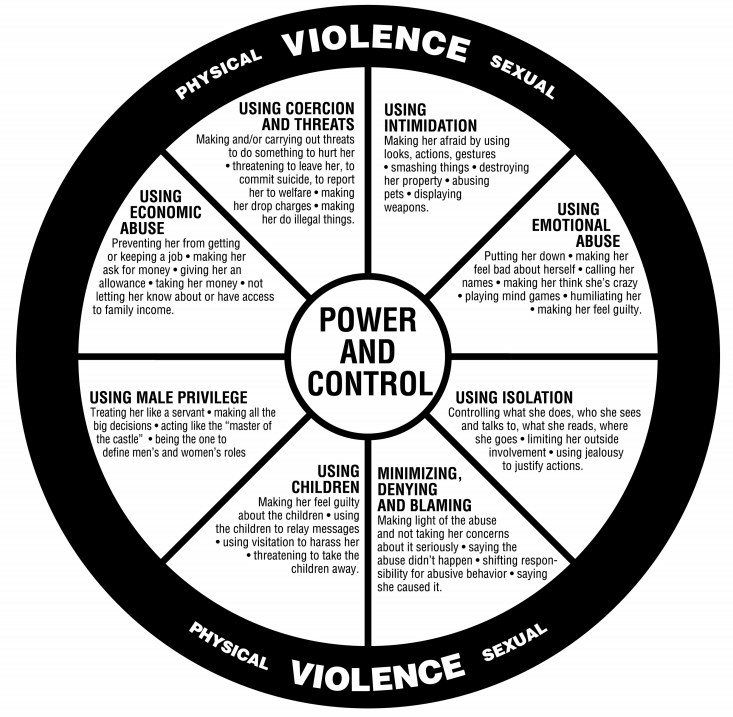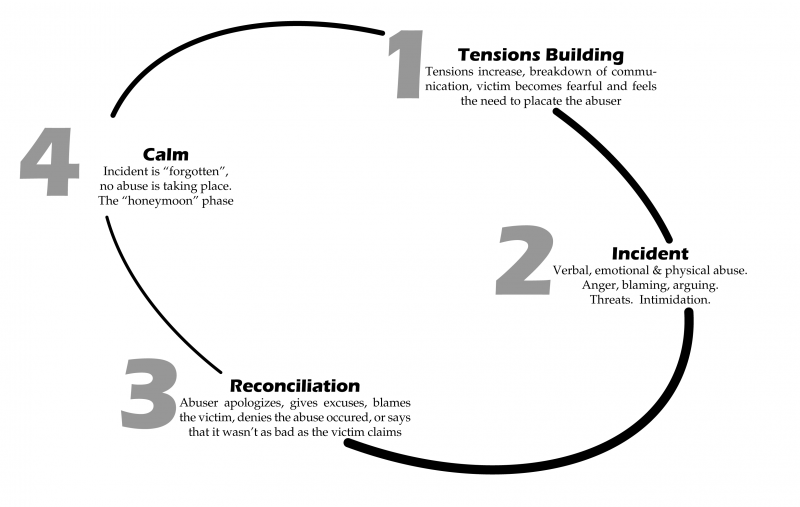Domestic violence is a pattern of violence, abuse, or intimidation used to control or maintain power over a partner who is or has been in an intimate relationship. Fundamentally, domestic violence is about power and control.
There are various forms of domestic violence, including physical, emotional, psychological, sexual, social, and financial abuse. Abusers often use more than one form of abuse to invoke fear or coerce a partner into behaving in ways they don’t want to.
The power and control wheel, developed by the Domestic Abuse Intervention Programs in Duluth, Minnesota, shows how domestic violence is a behavioural pattern — and how abusers may use different tactics to establish power and control.
Domestic violence often happens in cycles. The cycle of abuse happens when the abuser threatens violence, abuses the partner, apologises and promises to change, before starting the cycle again.
As the cycle shows, abusers may not be actively violent all the time; the mix of both violent and “honeymoon” phases is what makes abuse confusing — and hard to break away from. It is a tactic for abusers to maintain power and control. It is crucial that you recognise the signs of domestic violence and break the cycle.
Image from: Wikimedia Commons <https://commons.wikimedia.org/wiki/File:Cycle_of_Abuse.png>
There are a lot of myths about domestic violence in our society. Let’s dispel some of the common myths here.
- Myth: Domestic violence is only a momentary loss of temper.
- Fact: To view domestic violence as only something momentary is to minimise the issue. Domestic violence is about systematic control and abuse of power.
- Myth: Domestic violence happens only in poor families.
- Fact: Domestic violence can happen to anyone regardless of socioeconomic background.
- Myth: Domestic violence is only a slap or a punch once in a while and isn’t serious.
- Fact: Domestic violence is repetitive and habitual behaviour which can take the form of physical, psychological, social, sexual or financial abuse. Domestic violence causes serious suffering — not only physical injuries but also psychological trauma and distress.
- Myth: Heads of households have a right to control women.
- Fact: Heads of households have no right to control or to limit the freedom of women. Domestic violence is a grave violation of fundamental human rights.
- Myth: Survivors provoke their partners’ abuse and deserve to be hit.
- Fact: No one deserves to be hit. There are never any excuses for abusing a partner.
- Myth: Domestic violence is a private, personal matter
- Fact: The belief that domestic violence should be addressed within the family hinders survivors from accessing justice. Domestic violence is a crime under the Domestic Violence Act and must be addressed accordingly.
- Myth: Survivors can always easily walk away from the abusive relationship
- Fact: Because of the controlling nature of abusive relationships, survivors often find themselves trapped in the abusive situation. Feelings of shame and the lack of support also hinder survivors from walking away.
- Myth: If it’s so bad, the survivor would leave
- Fact: Factors such as economic dependence and the fear of escalating violence are barriers that hinder survivors from leaving. This is why it is so important to have support systems for survivors.
- Myth: The cycle of violence can easily stop
- Fact: Domestic violence involves maintaining power and control over a partner. Perpetrators often promise to change, especially after a violent outburst, as a tactic to control survivors and to prevent them from leaving. However, in many cases, the abuse is repetitive.
- Myth: Domestic violence doesn’t happen in my community
- Fact: Domestic violence may appear to be absent or hidden because of social norms that prevent domestic violence from being discussed openly. However, domestic violence can happen in any community, even if you do not see it happening.
- Myth: Domestic violence is an anger management issue
- Fact: Domestic violence is about power and control. In relationships, the power imbalance between partners takes the form of systematic control and devaluing of women. Domestic violence is not simply the result of impulsive anger; it is often systematic and deliberate. And there is no excuse for such behaviour.
Reference:
Domestic Abuse Intervention Programs, United States of America, ‘Wheels’ <https://www.theduluthmodel.org/wheels/>
家庭暴力的侵害行为可包括了实际攻击、伤害、虐待等直接实施暴力或在精神上威胁家庭成员。其涉及的成员可以指:配偶、前配偶、双亲、子女和继亲帶來的孩子、有血緣关系家人、同居伴侶、殘疾者与照顾者、情侶关系。 家庭暴力在不同国家可以采取多种形式,包括虐待女童、切割女性生殖器官、选择性堕胎、强迫堕胎、强迫卖淫、婚内强奸、荣誉处决、嫁妆杀害、因丈夫去世而被迫自焚等。
家庭暴力种类
身体虐待
当以伤害或危及您的方式对您使用身体攻击时,这被称为身体虐待。 人身攻击或殴打是犯罪行为,无论发生在家中还是家外,警察有保护您免受人身攻击的合法权利。
性虐待
当您被迫从事非自愿、不安全或有辱人格的性行为时,就会发生性虐待。 即使施虐者是与您自愿发生性关系的配偶或亲密伴侣,也是一种侵略和家庭暴力行为。 此外,性虐待会导致灾难性伤害并具有死亡风险。
语言虐待
施虐者经常会使用粗鲁、贬低或威胁性的语言来“管教”或“控制”施虐者。 许多家庭都遭受过这种虐待,这会对受虐待儿童的心理健康产生负面影响。
经济或财务虐待
施虐者经常使用金钱来控制受虐者。 经济或财务虐待包括以下内容:
- 严格控制受虐待者的财务状况或拒绝财务分摊;
- 避免使用金钱或信用卡;
- 让受虐待者对所有支出承担经济责任;
- 扣留基本必需品(食物、衣服、药物和住所);
- 防止受虐者寻找工作,做出自己的职业选择或阻扰受虐者上班;
- 窃取或诈骗受虐者的金钱。
社交虐待
施虐者之所以限制或隔离受虐者,是为了让施虐者能掌控和损坏受虐者与亲朋戚友或他人之间的关系。
通过限制受虐者与家人和朋友联络的方式或频率,便能破坏受虐者的形象与荣誉。
社交虐待包括以下行为:
- 禁止受虐者与亲朋戚友或他人沟通或见面
- 禁止受虐者离开住宅地方
- 禁止受虐者参与社交或社会性活动
- 施虐者必须知道受虐者的下落与行动,以及受虐者与谁见面沟通
- 施虐者特意破损受虐者的形象或羞辱受虐者
- 限制受虐者的交通使用权



